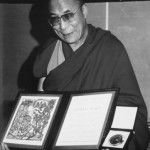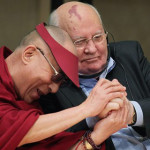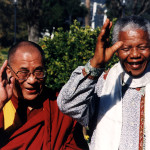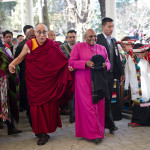Dalai Lama XIV Tenzin Gyatso (Tibet-China-India)
Nobel Peace Prize Laureate in 1989; the prize was awarded for his continuous preaching of kindness, love, and tolerance in the relationships between individuals, communities and peoples.
«The need of simple relationships between people becomes more and more necessary… Today the world has become even closer, and it increasingly depends on every individual. National problems cannot be solved by one country solely. Thus, if there is no feeling of personal responsibility for all, our survival is under a threat. Basically, feeling responsible for all is an ability to feel other people’s sufferings just like you would feel your own. We must realize that our enemies are also driven by a quest for happiness. All living creatures want the same things that we want».
(Dalai Lama XIV)
The fourteenth Dalai Lama1-to-be, Tenzin Gyatso, was born on July 6, 1935, in a farmer’s family in the village of Taktser in Amdo province in the north-east of Tibet, and received the name of Lhamo Dhondup at his birth. At the age of two he was discovered by a searching party of monks and recognized as the incarnation of Thubten Gyatso — late thirteenth Dalai Lama. Tibetan Buddhists believe that Dalai Lamas are manifestations of Avalokiteśvara – the bodhisattva of compassion and Tibetan patron.
(1 Dalai Lama is a unique title and honorary status. In the modern world Dalai Lama is the title of the ruler of Tibet. In the past, Dalai Lama was believed to be a reincarnation of Bodhisattva. Bodhisattva is an “enlightened being;” the term consists of two words: bodhi and sattva. In Buddhism this is a being (or a man) who possesses bodhicitta, and who has made a decision to become a Buddha for the benefit of all beings. When translated from Mongolian, the word “dalai” means an ocean, while lama (bla ma) in Tibetan language is equivalent to the Sanskrit word guru, meaning a teacher. The title of Dalai Lama is transferable. After the death of Dalai Lama, monks organize the searching for his next reincarnation. Usually, it is a small child that has to bear certain signs and must pass through some tests. The searching usually takes several years. Then the child is sent to Lhasa, where he is trained under experienced lamas).
When he was four years old, the new Dalai Lama was brought up to the Lion’s Throne in Lhasa; at the age of six he started his monastic training which he successfully finished summa cum laude in 1959 and received his PhD in Buddhist philosophy.
In 1949, the communist China sent their troops to invade the territory of Tibet. In 1950, Dalai Lama was asked to take upon himself all political authority, and he became the head of the state and of the government. One year later, a treaty between Tibet and China was signed, according to which Tibet became a part of the People’s Republic of China, and the Chinese guaranteed the integrity of the political, religious, and cultural institutions of the country.
Nevertheless, the Tibetans continued to actively resist the new Chinese authorities, and in 1959 mass anti-Chinese protests began in Lhasa. During the peak of the disturbances, Dalai Lama with a small group of personal attendants fled to India, and the insurrection was severely suppressed by the Chinese troops.
Indian authorities offered him an asylum, and Dalai Lama settled in the city of Dharamshala in the north of the country. In the following several months, close to eighty thousand Tibetans moved to India, and most of them settled down in the same area with their leader. Dharamshala is known as a little Lhasa, and it became the home of the Tibetan government in-exile that began to work there.
Dalai Lama headed up the efforts to preserve the Tibetan culture: an educational system was developed on the Indian territory to teach the refugees’ children their native language and culture. Tibetan Institute of Performing Arts and Central Institute of Higher Tibetan Studies were opened. The Tibetan leader tried to make the demands of his countrymen known to the international community in the face of the organization of the United Nations. In 1951, 1961, and 1965, the General Assembly of UN passed three resolutions calling for the protection of the Tibetan people.
In 1963, Dalai Lama presented a project of the democratic constitution of Tibet, which was later adopted under the name “The Charter of the Tibetans in-Exile.” It declared the freedom of speech, faith, meetings, and freedom of movement and travel. In 1990, the government in-exile was democratized. The cabinet of ministers that had been formerly appointed by Dalai Lama, and the Assembly of the Tibetan people’s deputies (Parliament in-exile) were dismissed. After that, in different countries of the world Tibetan emigrants took part in the elections of the new Parliament, and the Parliament elected the new Cabinet of Ministers. The next step on the way of democratization was made in 2001, when the emigrants chose in the direct elections the senior Minister of the Cabinet. The latter appointed the government, which was approved by the Parliament.
In the West, especially in the USA, the activities of Dalai Lama found support. In 1987, he spoke in US Congress presenting his plan of peace-making process in Tibet. According to the plan of the exile leader, Tibet had to become a wild nature reserve and a “peace zone.” Dalai Lama demanded to stop the mass migration of the Chinese Han people to Tibet. In 1988, he spoke before the members of the European parliament in Strasbourg with his new proposals. He was talking about the creation of the self-governed political system on the territory of the Tibetan provinces; and the republic of China would assume the foreign policy and defensive functions.
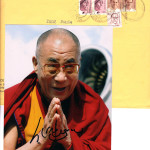
Autograph of Nobel Peace Prize Laureate Dalai Lama XIV, Kindly Presented by His Holiness. From My Private Collection
The Chinese side did not give any positive answer to the initiatives of Dalai Lama, and perceived them as a separatist threat; but in the West they received wide acclaim. In 1989, for the non-violent struggle for the freeing of Tibet, Dalai Lama was awarded the Nobel Peace prize. In the following years, the world renown of Dalai Lama grew, and he was in the center of close attention of the press. In total, starting from 1959, Dalai Lama XIV received over eighty awards, honorary doctorates and prizes; he published over seventy books.
Prior to Tenzin Gyatso, no other Dalai Lama traveled beyond the territory of Asia, and by the time of his ascension to the throne, not more than two thousand westerners visited Tibet. Now the leader of the Tibetan Buddhists turned into a figure of international significance. Beginning from the early 1970s, he traveled extensively, visiting more than sixty countries on the six continents, meeting with political leaders, monarchs, prominent scientists, and leaders of religious confessions, participating in inter-confessional God-worship services, and giving public speeches.
In the meantime, the dialogue with the Chinese authorities did not work out so well. In 1993, all negotiations were suspended for almost ten years. Some hopes for de-escalation appeared only in 2002, when Dalai Lama’s representatives visited Beijing and restarted the negotiations, although without any significant progress. Dalai Lama declared his continuous commitment to non-violent policy, and in 2006 he emphasized that he is not seeking the absolute independence for Tibet, but rather the status of autonomy. But the authorities of the People’s Republic of China still believed that Dalai Lama’s political line was a separatist one, and the latter in his turn blamed the Chinese for their non-compromise attitude and unwillingness to cooperate.
In 2006, Dalai Lama XIV received honorary Canadian citizenship. In the past, only two foreigners had been honoured with this privilege – Swedish diplomat Raul Wallenberg and South African Nelson Mandela; and one year later, the honorary Canadian citizenship was granted to human rights activist from Myanmar Aung San Suu Kyi.
In 2007, in view of the coming Olympic Games in the People’s Republic of China, the problem of Tibet once again became the center of the world community’s attention; and in the relationships between the administration in-exile and the Chinese authorities another crisis loomed. The point of collision was the matter of choosing Dalai Lamas and other hierarchs of the Tibetan Buddhism: the Chinese government wanted to have the right to approve the next reincarnations of lamas. To spite their plans, Dalai Lama announced that he would hold a referendum concerning the need to have his next reincarnation, and he did not exclude that he would choose his successor himself while being still alive. Also Tenzin Gyatso did not rule out the possibility that his future incarnation could be a female.
Against the background of growing tensions between Beijing and Dharamshala, the United States testified again of their support of Dalai Lama’s activities: in October 2007, to China’s irritation, the leader of the Tibetan Buddhists received the highest civilian award in the USA – the Congressional Gold Medal, which is bestowed for the successful efforts in the field of defending the national interests of the United States. Also back in the late 1990s, Dalai Lama’s administration officially recognized that it used financial support of the Central Intelligence Agency.
In March of 2008, new mass anti-Chinese protests sparkled in Tibet and Chinese regions with significant number of the Tibetan population, which resulted in clashes with the authorities and in human casualties. While commenting on the situation, Dalai Lama appealed to the world community again to put pressure on China’s authorities, characterizing the actions of the People’s Republic of China as a “cultural genocide” against the Tibetan people.
On March 29 of 2012, the John Templeton Foundation announced that Dalai Lama would be the next Laureate of the prize which is awarded for the “outstanding contribution to the strengthening of spirituality.” The prize with a check for 1.7 million dollars was solemnly presented at the Cathedral of Saint Paul in London on May 14, 2012.
This material was taken from the web resource: http://www.nobeliat.ru


